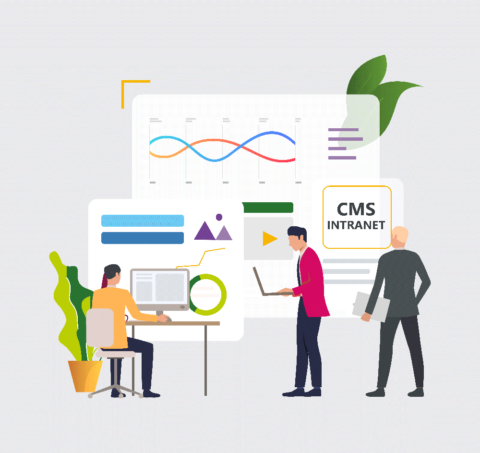Integrating a CMS intranet solution should help create less work, not more of it. Therefore, your intranet CMS must be carefully chosen to ensure its success. As you enter the planning stage, there are a few essentials to look for in a CMS intranet candidate. But first, let’s review how a content management system fits into your intranet structure.
What Is a CMS Intranet?
To begin, what is an intranet? Or, more specifically, what is an intranet strategy? Your intranet strategy is an internal network used for communication, collaboration, and information management within your organization. Over time, the amount of content required to convey this information snowballs to a volume that is difficult to publish and manage. An intranet CMS is a content management system that helps with every process step, from creating and publishing content to accessing, updating, and archiving it.
So how do you choose the right CMS intranet solution? We’ve compiled a list of ten things to check for to ensure your content management system is a tool that helps your employees rather than hinders them.

Intranet vs CMS Intranet: What Are Differences?
What Are the Benefits of Intranet CMS for a Company?
Collaboration is the key to success for any business, and a CMS intranet software should be able to facilitate it. Features such as shared calendars, task management, document sharing, and team collaboration tools will help improve employee collaboration.
Foster and Improve Collaboration
Effective internal communication is crucial for any organization. A CMS intranet can help. How? With features like employee directories, company news, and forums to improve employee communication.
Strengthen Your Company’s Values and Identity
Intranets can play a big part in strengthening your company’s values and identity. For example, a feature that allows employees to share their successes and achievements helps to create a positive company culture.
Enhance Your Onboarding Process
Did you know you can onboard employees on an intranet? For example, if it has a feature that allows new employees to access company policies and procedures, employee handbooks, and other important information, this space will help them become productive members of the team more quickly.
Measure the Success of Your Action
With the help of your intranet analytics, you can track employee engagement, communication effectiveness, and overall productivity.
Scalability
As your business grows and evolves, your intranet should be able to scale with it. Look for a CMS intranet software that can be easily customized and scaled to meet the changing needs of your organization. Do you need a mobile intranet? Do you have deskless workers? How many employees will be using the intranet? These are all questions worth exploring.
Why use a CMS intranet?
CMS intranets streamline internal communications and empower employees by creating a central hub for all work-related information. This user-friendly platform allows anyone to easily create, update, and share company updates, fostering transparency and boosting productivity through a well-informed and connected workforce.
How Do You Choose a CMS intranet?
1. Integration With Existing Technology
The most essential quality of an intranet CMS is that it integrates seamlessly with your intranet and with the full spectrum of digital tools your employees use daily. Make sure apps like instant messaging, project management, HR systems, and data analytics can all work fluently with the content management system without the need for cumbersome middle steps.
2. Intuitive User Interface
Varying levels of digital dexterity across an organization means that any widely used tools need to be intuitive enough for anyone to use with minimal training. A user interface that mimics tools and platforms employees are already accustomed to using – such as social media – helps improve adoption and efficiency. While this might sound trivial, it goes a long way in boosting the overall digital employee experience, which is associated with boosted employee happiness, employee engagement, higher profits, and even better customer service.
3. Responsive Design
Many employees use various devices, such as smartphones and tablets, to perform work functions. As this behavior is only expected to increase with time, it’s key that your content management system can be accessed from more than just a computer. Following the same line of thought, ensure any content published through an intranet CMS is enabled for responsive viewing across devices.
4. Support for Different Content Types
The content you distribute via your intranet as part of your internal communications strategy probably consists of many types, including text, photos, videos, presentations, and more. Multimedia support should be non-negotiable as you’re looking for a content management system.
5. Easy Deployment
The process of rolling out your CMS employee intranet solution may take some time. That said, the deployment process doesn’t need to be overly complicated. With so many off-the-shelf solutions that require relatively little configuration, there’s no need to spend months designing a custom solution as costs accumulate.
6. Regular Updates
The work isn’t completely done once you’ve deployed your CMS intranet. Content management systems need regular updates to stay abreast of industry trends, new technologies, and security threats. Make sure updates are released regularly in a way that doesn’t knock your entire system offline for long periods.
7. Searchability
An intranet CMS is useless if employees can’t find what they need. Look for a robust search function that supports multiple criteria and can filter content by properties such as type and date.
8. Analytics
As with all the technology your organization uses, your goal should be constantly striving to improve your CMS intranet over time. With analytics, you can easily see how employees interact with content, which types are most effective, how content is accessed and shared, and more. Integrated analytics are also useful in collecting data, such as employee survey responses, without jumping through hoops to process the results.
9. Governance Management
An intranet content management system can’t replace governance for your intranet, but it can certainly help. A good CMS can automatically update content with the newest versions, detect and flag duplicates, and even automate some processes like naming files. These small features will make a huge difference in how your content organization looks one, two, or five years later.
10. Customization
Every company’s intranet needs are different. Although you don’t need to build your content management system from scratch, having the ability to control and fine-tune certain intranet features and functions can make or break its success. Make sure you can adjust branding, tweak templates, and determine governance rules as needed. Your CMS intranet should adapt to fit your needs, not the other way around.
What Is the Best CMS Intranet?
When looking for an intranet content management system, the first step is to narrow down your options based on what works with what you already have. Ultimately, the best CMS intranet software is the one that best fits your organization’s specific needs. Be sure to carefully consider the features and functionality that are most important to you and choose an all-in-one intranet software that can help you achieve your goals.
Microsoft Sharepoint
Microsoft SharePoint is a popular choice for businesses looking to implement a CMS intranet solution. It is a web-based collaboration and document management platform that is part of the Microsoft 365 suite of tools. SharePoint offers a wide range of features that can be used to create a variety of intranet sites, including employee portals, knowledge management systems, and social intranets. One of the main advantages of using SharePoint as a CMS intranet is its compatibility with other Microsoft tools such as Office 365 and Teams, which allows for seamless integration and enhanced collaboration. Additionally, SharePoint offers robust security features and can be easily customized to meet the specific needs of your organization.
However, SharePoint is not a very user-friendly system, and it can take a lot of time and resources to create the perfect SharePoint intranet for your organization. An off-the-shelf solution like Powell Intranet could be the answer. Powell Intranets is a third-party solution that enhances the use of SharePoint as a CMS intranet. It is a pre-built intranet software that works seamlessly with SharePoint and Microsoft 365. Powell Intranets offers a wide range of features and functionalities that can help you make the most out of your SharePoint intranet solution. Using Powell Intranets in conjunction with SharePoint, you can create a robust and user-friendly intranet that streamlines communication and improves productivity.
Powell Intranets’s content management system is the perfect off-the-shelf solution that comes prebuilt with all the necessary tools to help you deploy your CMS intranet software in record time.
Other Intranet Solutions to Create an Intranet CMS
There are several other intranet solutions available to create an intranet CMS. A popular option is WordPress. This open-source content management system is highly customizable and can be used to create a variety of intranet sites, including employee portals, knowledge management systems, and social intranets. However, it does not meet the needs of every organization and is better suited to creating external, public facing websites.
How Do You Implement a CMS Intranet Solution?
Implementing a CMS intranet solution involves several steps. First, you should identify the specific needs and goals of your organization, and choose a CMS intranet software that can meet those needs. Next, you should set up the software, which typically involves configuring the system, uploading content, and creating user accounts. Once the software is set up, it is important to train your employees on how to use the system effectively. Finally, you should monitor the system’s performance and make any necessary adjustments to ensure that it is meeting your organization’s needs. It is also important to consider involving stakeholders and employees in the process to make sure that everyone is on board and the solution is tailored to the needs of the users.




